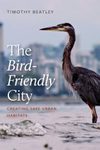By: David Pearlmutter(Editor), Carlo Calfapietra(Editor), Roeland Samson(Editor), Liz O'Brien(Editor), Silvija Krajter Ostoić(Editor), Giovanni Sanesi(Editor), Rocío Alonso del Amo(Editor)
351 pages, 75 colour photos and colour illustrations, 4 b/w illustrations, 10 tables
![The Urban Forest The Urban Forest]()
Click to have a closer look
About this book
Contents
Customer reviews
Related titles
About this book
This book focuses on urban "green infrastructure" – the interconnected web of vegetated spaces like street trees, parks and peri-urban forests that provide essential ecosystem services in cities. The green infrastructure approach embodies the idea that these services, such as storm-water runoff control, pollutant filtration and amenities for outdoor recreation, are just as vital for a modern city as those provided by any other type of infrastructure. Ensuring that these ecosystem services are indeed delivered in an equitable and sustainable way requires knowledge of the physical attributes of trees and urban green spaces, tools for coping with the complex social and cultural dynamics, and an understanding of how these factors can be integrated in better governance practices. By conveying the findings and recommendations of COST Action FP1204 GreenInUrbs, The Urban Forest summarizes the collaborative efforts of researchers and practitioners from across Europe to address these challenges.
Contents
Preface
Contributors
1. Environmental services provided by urban forests and green infrastructure
1.1. Introduction: Urban trees as environmental engineers; Roeland Samson
1.2. Ecosystem services: The environmental components
1.2.1. The Urban Heat Island: thermal comfort and the role of urban greening; Jelle A. Hiemstra et al.
1.2.2. Urban trees and their relation to air pollution; Roeland Samson et al.
1.2.3. Carbon sequestration by urban trees; Silvano Fares et al.
1.2.4. Water regulation and purification; Ursa Vilhar
1.2.5. Soil quality; Miglena Zhiyanski
1.3. Delivery of goods and services; Abhishek Tiwary et al.
1.4. Biodiversity as support for ecosystem services and human wellbeing; Pedro Pinho et al.
1.5. The cost of greening: Disservices of urban trees; Paloma Carinanos et al.
1.6. Case studies: Modeling the atmospheric benefits of urban greening; Ana Isabel Miranda
1.7. Assessing the ecosystem services deliverable: The critical role of the Urban Tree Inventory; Naomi Zurcher
1.8. Species-specific information for enhancing ecosystem services; Roeland Samson et al.
1.9. Conclusions and recommendations; Roeland Samson
2. Socio-cultural services provided by urban forests and green infrastructure
2.1. Introduction: Socio cultural services of urban forests and green infrastructure; Liz O'Brien
2.2. Social and environmental justice: Diversity in access to and benefits from urban green infrastructure - examples from Europe; Liz O'Brien et al.
2.3. Recreational use of urban green infrastructure: the tourist's perspective; Theano S. Terkenli
2.4. The role and value of urban forests and green infrastructure in promoting human health and wellbeing; Guiseppe Carrus et al.
3. Economic benefits and governance of urban forests in a green infrastructure approach
3.1. Introduction: Governance and economic valuation; Natalie Gulsrud, Silvija Krajter
3.2. Challenges to governing urban green infrastructure in Europe - the case of the European Green Capital Award; Natalie Gulsrud et al.
3.3. The role of partnerships and the Third Sector in the development and delivery of urban forestry and green infrastructure; Ian Whitehead et al.
3.4. The Value of Valuing: Recognising the benefits of the Urban Forest; Kenton Rogers et al.
4. Summary
4.1. Introduction: Tying it all together; Rocio Alonso del Amo, Giovanni Sanesi
4.2. Linking the environmental, social and economic aspects of urban forestry and green infrastructure; Nerys Jones, Clive Davies
4.3. Growing the Urban Forest: our Practitioners' Perspective; Naomi Zurcher, Maria Beatrice Andreucci
Subject index
Customer Reviews
By: David Pearlmutter(Editor), Carlo Calfapietra(Editor), Roeland Samson(Editor), Liz O'Brien(Editor), Silvija Krajter Ostoić(Editor), Giovanni Sanesi(Editor), Rocío Alonso del Amo(Editor)
351 pages, 75 colour photos and colour illustrations, 4 b/w illustrations, 10 tables





































